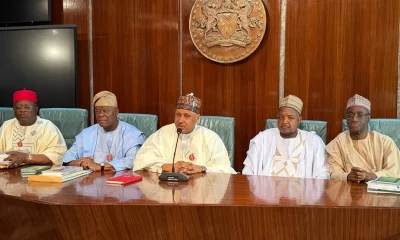Education
Preparing African educational systems for Blockchain
Published
6 years agoon
By
Olu Emmanuel
Education is evolving due to the impact of the Internet. We cannot teach our students in the same manner in which we were taught. Change is necessary to engage students not in the curriculum we are responsible for teaching, but in school. Period. – April Chamberlain
The proliferation of the internet all across the world with instantaneous connections allows the sharing of information and collaboration on a global scale. This has driven the explosion of exponential technologies, including artificial intelligence, quantum computing, and blockchain.
I was introduced to Blockchain technologies last year when I participated in MIT Innovation and entrepreneurship bootcamp in Brisbane, Australia last year. There were people from all over the world over 120 people selected from the thousands who applied for the program to utilize the methods created by MIT’S technical research teams. We were to solve a problem/challenge in the real world with a team of people we had never met before we got to the program.
My team chose to solve the issue of prescription drugs abuse by patients who jumped from Doctor to Doctor; clinic to hospital- fixated on getting prescription slips so that they can get the drugs that they are addicted to.
We used blockchain technology to create profiles for each of the patients that could be transferred to other Doctors and medical facilities.
I was impressed with how secure and exponential the solution was.
Recently I began to think about it and how it could be important and why it matters for the education world. I want to emphasize the principles and purpose driving this technology more than the particulars of the technology because of its potential to solve the complex issues of education.
What is blockchain all about anyway?
Blockchain is a construction of computing that uses cryptography to connect a increasing list of records, called blocks, organized in an open and dispersed record. The design of the blockchain makes it impervious to modifying the data. It debuted publicly in 2008 when its application to financial systems was discussed in a Bitcoin whitepaper.
It was centered around a peer-to-peer version of electronic cash to allow online payments to be sent directly from one party to another without going through a financial institution.
It has inspired people to apply this technology beyond finance, such as in law, health, and philanthropy. In the midst of all of this is the premise that value can circulate to people without intermediaries.
Blockchain solutions in education
The three approaches that Blockchain could take in education are as follows-:
1) Practical: Blockchain technology could be used to create digital credentials that could be tracked and verify the identity of the users.
2) Educational: instructing students and the general populace about blockchain technology and growing the research in this area
3) Social: The application of the principles of blockchain technology to educational policies.
There is a lot of work surrounding 1 and 2 all around. I’d like to focus on 3 because it could have the largest impact on our education systems. The issues that we grapple with in education, either equity and access to quality education; student debt, or boosting the capacity of teachers, could be assuaged if we redesigned how we shape our educational institutions.
Our education systems still have a long way to go; almost 303 million children aged 5 to 17 are out of school worldwide3. Even for those attending school, we can’t guarantee that they are having access to quality education. The disparity between our best and our worst schools is ever increasing and even the best schools are seeing a mismatch towards the job market.
It’s another cycle and it’s the 4th industrial revolution.
The purpose of education should be centered around the developments in other industries. Previously when a feudal society existed, noblemen and ruling families were the only ones who had access to education, they were taught individually by groups of reserved experts. Afterwards, the advent of the industrial revolution helped democratize educational access for all. This model of education was free for the masses. This means that in keeping up with the trend- we have evolved to a networked model because of the internet, we learn remotely and access content from anywhere.
Are we ready for this?
This is a call to action for those in the education space in Africa, from various backgrounds, particularly teachers and students. Be curious about what this technology can do, undertake your own research and try it out. If you’re grappling with it, you can reach out to me and I can discuss it’s applications with you. I was taught by professionals and I am still learning from them.
Remember, we have a lot of work to do together to tame the beast called “lack of quality education.”
Adetola Salau; Global Educator / International Speaker / Author/ Social Entrepreneur/ Innovative Thinker/Future Readiness Advocate/ STEM Certified Trainer
She is an Advocate of STEM Education and is Passionate about Education reform. She is an innovative thinker and strives for our society & continent as a whole to reclaim it’s greatness.
E-mail-:[email protected]
facebook-: Carisma4u
twitter-: @Carisma4u
Website-: www.carisma4u.com
Trending

 Business1 week ago
Business1 week agoPresident Tinubu, Minister Wale Edun and Nigeria’s Fiscal Profile: The Truth and the Lies

 Latest3 days ago
Latest3 days agoNigeria’s kidnap-for-ransom industry nets N2.57bn in one year

 Business1 week ago
Business1 week agoSAGLEV clinches 2025 Nigeria EV Brand of the Year Award

 Business1 week ago
Business1 week agoOtedola deepens grip on FirstHoldCo with Fresh N14.8bn Share Purchase

 Latest1 day ago
Latest1 day agoReactions follow US strikes on terrorist targets on Christmas Day

 Politics1 week ago
Politics1 week agoFEC approves N58.4 7trn for 2026 budget proposal

 Latest4 days ago
Latest4 days agoU.S. to enforce partial visa suspension on Nigeria, 18 other countries from January 2026

 Latest2 days ago
Latest2 days agoPresidency debunks viral claim of change in Tinubu’s Chief of Staff

